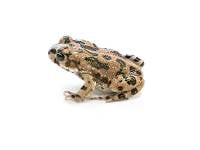Josh's Frogs
Why you should buy from us
African Green Toad - Bufotes boulengeri
Name
African Green toads go by the scientific Bufotes boulengeri. It is typically called the African Green Toad, and sometimes the Sicilian Green Toad. This species was moved out of the genus Bufo in 2013. This toad is in the family Bufonidae, and is considered a true toad.
Recommended Vivarium Size
Housing Bufotes boulengeri can be tricky due to their preference for more arid enclosures. These anurans require a humid hide, often somewhat underneath the top layer of the substrate. Something the size of an 24x18x12 Exo Terra Glass Terrarium can house 2-3 adults, while a 20 gallon long could house about the same amount of toads. Ventilation is a must, as these toads will not tolerate stagnant moist air for very long. A screen top will help provide this. Substrate recommendations vary considerably, but we have found that Josh’s Frogs Desert Biobedding works well. Provide plenty of décor that your African Green Toads can climb and hide in, such as cork bark tubes and flats, or rocky structures like slate. Our toads really seem to like the Exo Terra Smart Plants. A shallow water bowl should be provided as well. African Green toads will benefit from UVB lighting such as a 5.0 or UVB100 UVB bulb.
Temperature
They can tolerate temperatures from 70F to over 85F, but ideally are kept slightly warmer than room temperature, from the mid to high 70s. A low wattage basking spot can help to elevate temperatures into a safe range.

Humidity
In the wild, precipitation and humidity fluctuate based on season, with a light rainy season in the early part of the year. African Green toads can handle a wide range of humidity levels, but prefer humidity levels around 40-60% with plenty of ventilation/air movement. Moist, stagnant air is a big no-no when keeping older Bufotes boulengeri, while very young animals dry out easily and prefer an elevated humidity. Routine spraying and a full screen top will aid in providing proper humidity levels. African Green Toads handle short periods of low humidity much better than most tree frogs.
Size
Adult African Green toads are moderate in size, and there is sometimes a size difference between males and females. An adult male may reach between 2.5-3 inches. A large female will be larger and bulkier than a male, and may measure up to 4 inches. All of the African Green Toad toadlets Josh's Frogs sells are well started juveniles, and measure about 3/4"" long. When they come out of the water, they are typically just under 1/4"" long but can be larger.

Age
There isn't any good data surrounding the average lifespan of African Green Toads, but wild caught animals have lived in captivity for 5 or more years. Due to the size and maturation rate likely being at least 1 year, African Green Toads can likely live in captivity for more than 7 years. All African Green Toads for sale at Josh's Frogs are well started juveniles, and are 2-3 months old.
Feeding
African Green Toads like to burrow, and oftentimes spend a lot of time underground during the day under hides or cork flats/tubes and tend to be more active at night. You should plan your feeding times accordingly. African Green Toads can eat ½” to ¾” crickets as adults. Young African Green Toads start life feeding on springtails or pinhead crickets. At the size Josh’s Frogs sells captive bred African Green toads, they are eating 1/8"" to 1/4"" crickets. All prey items should be dusted with a quality vitamin/mineral supplement.
Sexing
Sexing adult African Green Toads is quite easy when you know how to do it. Once the toads are about 10-12 months old, they display subtle sexual dimorphism. Females are a bit larger than males, and more rotund. Males are a bit smaller, more slender, and emit a release call when grabbed around the belly. Males will also have a dark nuptial pad and robust forearms to facilitate in amplexus. Females tend to be more red than males but this exists on a spectrum and is not a completely reliable indicator of sex.
Color/Pattern
This species can vary widely across its natural range. All toads have green or olive splotches dorsally. Their base coloration can range from reddish brown to green to creamy.

Social Behavior
These toads are not outwardly aggressive towards each other, and do great housed in groups. During breeding, males can and will amplex without discretion and sometimes even end up with multiple males amplexing a single female. As long as the individuals are able to keep their heads above water this behavior is not harmful but for this reason a male to female ratio of 2-3:1 is recommended for breeding.
Breeding
Males will typically call from the water and amplex receptive females. In the wild, their breeding season can range from January to June and again from September to November.
Natural Range
Algeria, Egypt, Italy, Libyan Arab Jamahiriya, Morocco, and Tunisia.
History in the Hobby
African Green Toads are a typically uncommon species to find in the hobby.
Links of Interest:


